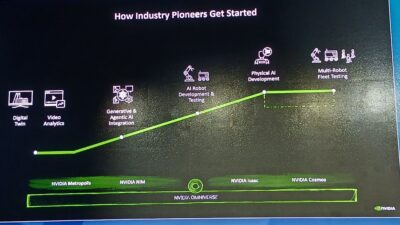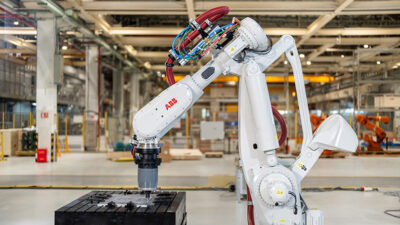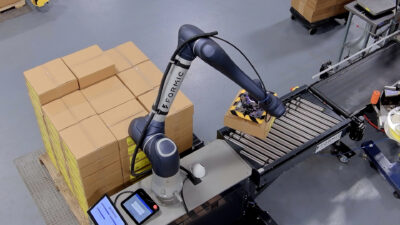Robotic welding automation, more common for many manufacturers, but it is fraught with potential issues that takes time and effort to resolve. See five methods for operational excellence in robotic welding in the short- and long-term.

When it comes to any manufacturing process and not just improving robotic welding automation, companies should be asking what their goals are.
“People start doing things without knowing what the end goal is, and that can be very costly,” said Will Healy III, industry strategy manager at Balluff, in his presentation “5 Steps to Creating Operational Excellence in Robotic Welding Automation,” which was given at Fabtech Expo at McCormick Place in Chicago.

The four things companies should be asking before jumping headfirst into robotic welding automation are:
- Improve asset utilization and machine availability
- Shorten planned downtimes, setup and changeovers
- Stop fighting fires and doing last-minute bootstrap repairs
- Reduce unplanned downtime and small stops.
“Downtime is killing us in robotic welding.” Healy said. He cited a few sources saying that it can be anywhere from $17,000 per incident to $22,000 per minute in the automotive industry. He highlighted this by mentioning a car manufacturer that produces a new vehicle every 50 seconds. Working that out to an hour, that’s over $1 million this company would end up losing because a system went down.

Common robotic welding automation problems, best practices
Healy highlighted many aspects in robotic welding automation that can cause problems for robotic welding. These include weld spatter, loading impact, sensor damage, improper cylinder position detection, broken nut detection and non-contact coupling. Each issue, unchecked, can cause significant damage to the machine and cause severe downtime.
“There is a lot of maintenance and awareness required because robotic welding is a very rough industry. Wear and tear is a given.”
Manufacturing has taken many steps forward in the technologies available as well as the materials. Metals are not made of one substance anymore; they come in different composites designed to be lighter and tougher. They can withstand the abuse better. Sensor technology has followed suit and can now detect items at greater distances. They don’t need to be right on top of the machine, which could damage the sensor and the machine because of weld spatter or a cable getting burned through.
Operators also have more information available at their fingertips thanks to the Industrial Internet of Things (IIoT) and input/output (I/O) architectures such as IO-Link, which Healy likened to USB for automation. Faster and more reliable communication is a must in an industry that is producing goods at greater rates than before.
“If we want to keep downtime to a minimum, I want my diagnostics to always communicate,” Healy said.

Using this data can help improve predictive maintenance and condition monitoring by giving operations the information they need ahead of time. Knowing what might or will likely happen, particularly in an industry that produces heavy wear and tear, can keep operations running smoothly.
Healy also cited machine vision and traceability, particularly radio frequency identification (RFID) as ways to give out information wirelessly and ensure the right information is going to the right people.
Five steps to creating operational excellence in robotic welding automation
There are many challenges and solutions in robotic welding automation, but knowing where and how to start is among the biggest. While it can be daunting, Healy laid out five steps for companies to use to improve their automation and plant-floor strategy.
Step 1: Get started. No seriously, right now. Healy said the best place to start is with something small. Identify the most troublesome workcell and perform an audit. What area has the most downtime, quality issues and changeouts? After identifying this, go out and ask the operators and maintenance crews and gather as much data as possible.
“The data doesn’t have to be perfect,” Healy said. “and identifying them and getting a general idea of what is going wrong. Data provides answers and potential solutions and what’s causing problems, and why it is happening.”

Step 2: Attack individual sensing applications in the robotic welding application
Once a workcell has been chosen and the basic information has been gathered, it’s time to look at individual sensors and learn what is and isn’t working. Healy outlined this as a four-step process.
- Select the right sensor. This is a trial-and-error process and the best technology may require some testing before the correct one can be determined. Users can narrow this down by asking how the sensor is being used, the environment it’s being exposed to and why the current installation keeps failing.
- Protect the sensor. The best accessory for the specific application may require some adapting to get the best results. Users should learn how much protection is needed and whether physical damage is harming the sensor. They also should determine available space and what the sensor is being exposed to.
- Connect with protection. Doing this correctly can extend the life of a product many-fold because the right coating or seal is protecting the sensor. Knowing whether the sensor is being exposed to elements or is being damaged due to high temperatures is critical.
- Learn with continuous improvement. Healy said this is the most important and the hardest step. Taking the lessons from what failed and what went wrong and applying them to other aspects is not a given. Sometimes the lessons are specific and sometimes they can be applied in many different circumstances.
Step 3: Fix the now. MRO purchasing and tool crib improvements. Commonizing inventory and reducing clutter by simplifying purchasing and reducing stockouts are other trial-and-error process. Many maintenance departments might not be a model of cleanliness and order, but getting a working idea of what is on hand and narrowing it down can reduce headaches and give a better understanding of total cost of ownership (TCO) and the return on investment (ROI).
Step 4: Create a mindset of responsibility. Healy admitted this might be the hardest part of the process. It’s one thing to document the challenges and give recommendations, but implementing them and keeping it consistent is another matter. Workforce culture, particularly in engineering, is about consistency. Many of the practices established have become ingrained. Changing that won’t happen overnight.
Documenting the ROI in specific detail can help. This gives others a concrete idea of how severe the problem is and convince others of the value of changing protocols.
If there is a general agreement on making these culture changes, continuous improvement training can help manufacturers identify issues such as:
- What are the common failures and agreed solutions to these problems?
- What are the best technologies for specific processes in the plant?
- How do you install and replace a sensor when it fails?
- What is done to avoid repeated failures?
“For manufacturers who really embrace these steps, it does get better if you do it,” Healy said.

Step 5: Fix the future with new equipment specifications
If users don’t change their machine specifications, the next machine installed will have the same problems all over again. Luckily, many manufacturers are specifying down to the methodology level so everything is spelled out. Getting everyone on the same page can be a challenge, though. Healy said companies need to be clear with and shift expectations accordingly. Know the TCO and ensure the best practices being applied are inside the equipment.
Achieve operational excellence, workplace culture for welding robotic automation
Operational excellence comes in many forms and there are many aspects, but companies can start by asking how to reduce costs, boost productivity and establishing long-term partnerships. These are already top of mind for many companies, but it’s an even greater priority now.
Improving automation and efficiency through concepts such as IIoT and asset management, are no longer a “want-to-have.” Due to the COVID-19 pandemic creating a paradigm shift in how things are created, it’s become a “must-have” to stay competitive.
Healy said of the priority change, “I think that’s part of it, yes, but it’s not just COVID-19 by itself. I think the workforce shortage and many other issues affecting manufacturing had a role in this. I think many who attended this event realize they have to do something different. They can’t keep doing the same things.”
Starting might seem daunting, but Healy said it’s all about recognizing things cannot be the same and starting from there.
“Pick something you saw today that you can get started with,” he said. “Everything is about the first step.”
Chris Vavra, web content manager, Control Engineering, CFE Media and Technology, [email protected].



